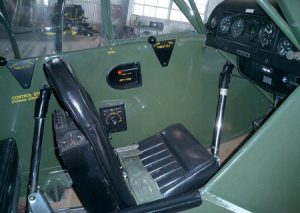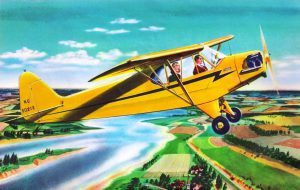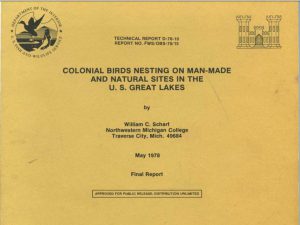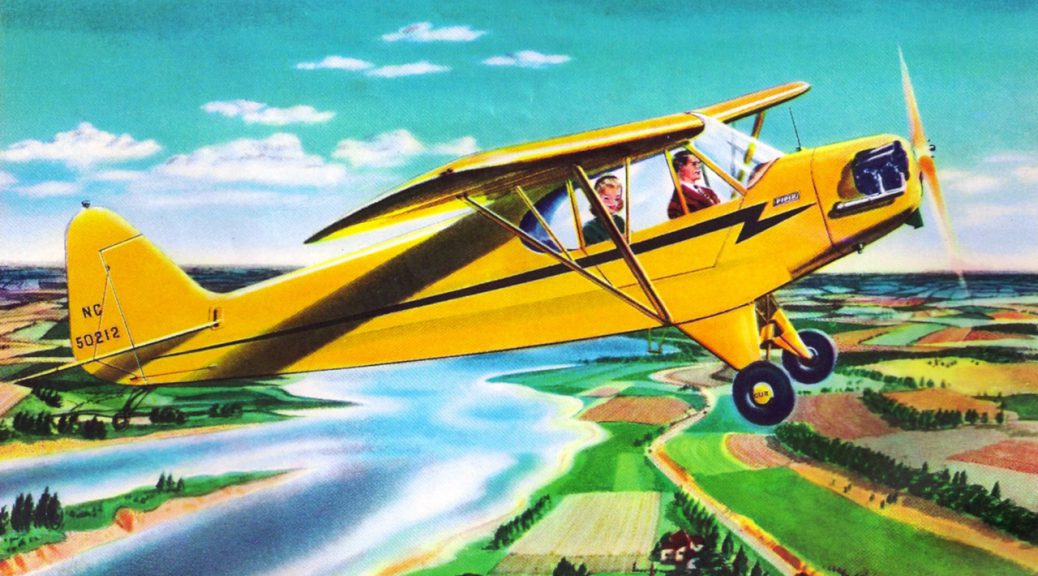by William C. Scharf

I looked back at John from the front seat of the two-seat 1946 Piper Cub (PA-11). He had a firm grip on the control “stick” that was the main steering for the aircraft that was thirty-years old when I was its passenger in 1976. In this particular plane the “stick” was located in the back seat to facilitate dual-control training of novice pilots when a second “stick” was added for the front seat.
Piper Cubs were built in profusion (just shy of 20,000) before, during and after World War II. They had a tubular frame covered with fabric. The Cub’s little engine was around 65 horsepower; the manufacturer equipped the plane with engines built by several companies. There was no starter. Instead the pilot spun the propeller by hand until it started. The pilot was best advised to take great care to get out of the way of the propeller when the engine began to run. It could power the plane at 75-80 miles per hour– even with the floats that were used for landing on the water. When flying a Cub near a freeway, it is not uncommon to be outpaced by the cars below.
Piper Cubs, because of their simplicity and reliability, are still highly sought after. A large number of those built are still flying. Originally, most Cubs sported a snappy yellow paint job, but the one I was now riding in was painted all green. Hence, this plane’s nickname, the “green machine.”

It was Friday May 7, and just a few days earlier I had entered into a cooperative contract with the Fish and Wildlife Service and the Corps of Engineers to find and count nesting colonial waterbirds (gulls, terns, and herons) up to one mile inland along the U.S. Great Lakes shoreline. This was the first such census attempted in two consecutive seasons by a single group. The findings are summarized in my two books published by the sponsoring agencies. Each book has a different emphasis and they complement each other describing the whole project.
Because of other work commitments, John, my pilot, asked me to meet him at three in the afternoon at Spider Lake, where the “green machine” was kept. I was itching to “get my feet wet” in this my new bird census endeavor. I had never flown in a floatplane before, but had been convinced by a number of pilot friends that it was the perfect way to find the waterbird colonies, and then land to make a definitive count.
We headed southeasterly in the “green machine” over land toward the Ohio coast of Lake Erie to search for bird colonies. My thought was to do the southerly colonies first because the nesting started earlier there. It took our plodding Cub about three hours to get to the lakeshore and by then I felt a need to let out some of the coffee I had with lunch. John landed the plane near the shore of the Woodtick Peninsula and said I should stand on a float and let the coffee go. It is best to hold on tight to the plane while standing on the float! Hmm, so this is how we function in floatplanes?

From there we flew up the Detroit River. I saw a few heron colonies and a couple of ring-billed gull colonies. The heron nests were easily counted from the air by circling, but John was reluctant to land at the gull colonies because the river current seemed too overwhelming for our little plane on take off. We gradually noted that it was getting late in the afternoon and mutually decided to search a portion of Saginaw Bay near Bay City before heading back to Spider Lake. I took some nice aerial photos of Channel and Shelter Islands near the Weadock power plant. These were the last aerial photos of this site before the islands were covered with dredged-material in order to deepen the Saginaw River shipping channel. The resulting new man-made island is now called the Saginaw confined disposal facility (CDF).
Now, the sun was going down fast. The retreating orb in the west was a beautiful sight from our altitude. The sinking sun, as we flew toward it, highlighted the curvature of the earth. The temperature had dropped, and it occurred to me that we faced an over land trip of more than two hours in progressive darkness and cold until we got back to Spider Lake. The pilot, John, seemed to be nodding off probably due to the fatigue of his regular job, flying airmail routes at night. He had flown on Thursday night, and was “off” now for Friday and Saturday nights. His upcoming time off was how he rationalized taking me in search of colonial nesting birds this afternoon. This was truly “moonlighting.” I looked back and his eyes were closed, although his hand seemed firmly on the “stick.” I said loudly, “John are you asleep?” To which he opened his eyes and said, ”just resting my eyes.” I am still not convinced of that.
As it grew darker, I said to John, “Is it about time to turn the lights on?” To which he answered, “don’t have any.” He added, “If someone else is coming we’ll see them first.” He indicated, pointing at the glass overhead window, a common standard element between the two wings of most Piper Cubs, “there’s nearly a full moon tonight with plenty of light to see things.” I took little comfort from that, but what choice did I have?
I sat quietly in the cold and dark until I finally could see the lake that John was aiming for. We descended in the darkness, despite the abundance of moonlight. Once the plane had dropped below the tree line the moonlight provided no benefit to see objects on the water.

I was picturing a late supper as we made our straight-in glide path to the cove we had departed from 6.3 hours earlier. Ah, the prospect of dry land again. But then, just as our floats were about to touch the water, a fisherman arose in a boat straight ahead of us. He held a flashlight in his hand and he was as convinced as I was that the approaching “green machine” represented his and our impending doom. John quickly, and in a panic, yanked the stick back, and we narrowly avoided a collision.
That was my first floatplane trip. I have managed to overcome my initial aversion, and have since spent many productive hours between sky and water doing bird censuses in newer and faster aircraft on floats. Some of the makers of these sleek floatplanes include: Cessna, Piper tri-pacer, Helio Courier, Fairchild, Seabee, and Maule, but none was as memorable as my first flight in the “green machine.” I have also had several floatplane pilots over the years and I want to thank them: Don, Ray, David, and Billy as well as John.
 For those interested in the results of Bill’s study, he reports:
For those interested in the results of Bill’s study, he reports:
We found 267 colonies, mostly gulls, but also terns herons and cormorants, on islands. Some ring-billed gull colonies were over 50 thousand nests and took ten people 2 days to count. The study area spanned 522 miles (No.-So.) and 787 miles east to west. From Pigeon Pt, Minnesota to Cape Vincent, New York.
The original paper may be found online at the Northwestern Michigan College library:
Scharf, W. C. 1978. Colonial Birds Nesting on Man-made and Natural Sites in The U.S. Great Lakes. Tech. Rpt. D-78-10, U.S. Army Engineer Waterways Expt. Sta. Vicksburg, Miss. 136p. + Append. A-D.
Bill Scharf is Professor Emeritus at Northwestern Michigan College where he led students on scientific study trips on Lake Michigan islands for 27 years. He holds an undergraduate degree from the University of Wisconsin Stevens Point, and Masters and Ph.D. from the University of Minnesota. He has studied harriers in Wisconsin and Orkney, Scotland, colonial nesting seabirds and migrating songbirds on the Great Lakes, and for 4 years after his NMC retirement, was Associate Director of the Biological Station at the University of Nebraska. While in Nebraska he wrote the Birds of North America account of the Orchard Oriole as well as studies on islands in the Platte River. He returned to Michigan to direct the Whitefish Point Bird Observatory, and currently resides in Traverse City.


